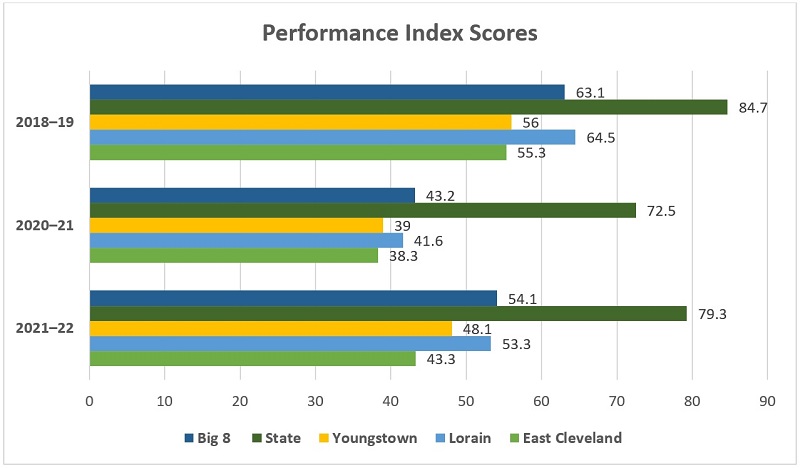In the summer of 2021, Ohio lawmakers caved to political pressure and created an off-ramp for the three districts under an Academic Distress Commission (ADC): Youngstown, Lorain, and East Cleveland. As part of the deal, each district’s board was tasked with developing an academic improvement plan that contains annual and overall improvement benchmarks. If districts meet a majority of these benchmarks by June 2025, their ADC will be dissolved.
Official implementation of the plans doesn’t begin until the 2022–23 school year, which means the recently released report card results should be the baseline for district improvement. Unfortunately, only one of the three districts (Youngstown) opted to include more than two state test measures in their plan. Even then, the rigor was severely lacking. This is a problem—as is the state’s decision to approve the plans anyway—because state tests are among the best methods for tracking improvement over time, among subgroups, and between districts and the state average. Failing to take these measures into account means that these districts could be among the lowest performing in the state by 2025 but still be free of state oversight just because they met their own self-appointed “improvement” benchmarks.
Fortunately, just because these districts steered clear of state tests doesn’t mean we have to. Here’s a look at how they fared in achievement, progress, and early literacy on the most recent state report cards.
Achievement
Achievement is the only test-based report card indicator that appears on all three district improvement plans. Specifically, the plans focus on performance index (PI) scores, which measure the state test results of every student and award districts points based on the state’s six achievement levels. The higher a student’s achievement, the more points the district earns. For example, a student who scores at the advanced level earns their district 1.2 points, while a student testing at the basic level (just below proficient) earns 0.6 points.
The chart below depicts performance index scores in ADC districts, with averages from the state and the Big Eight districts included for comparison. It’s no surprise that scores statewide and in each district dropped during 2020–21, as that year was dominated by pandemic-related disruptions and school closures. It’s also important to remember that the PI calculations award zeros when students do not participate in state assessments; the number of untested students was significantly higher in 2020–21, and that likely depressed some districts’ PI scores even further. Thus, although the chart shows that PI scores from the most recent school year are moving back toward pre-pandemic levels, it could be a reflection of test participation rates returning to normal rather than an indication of a robust academic recovery. In any case, all three districts’ most recent PI scores still fall well beneath their respective scores from 2018–19.
The 2018–19 results indicate that districts had their work cut out for them long before pandemic learning loss hit, as all three were at least 20 points below the state average. But the 2021–22 results reflect even bigger gaps between the districts and the state average, as the differences grew to 26 points in Lorain, 31 points in Youngstown, and a whopping 36 points in East Cleveland. Compared to Big Eight schools, the ADC districts fare a little better. In fact, the gap between Lorain and the Big Eight on the most recent report cards was less than one point. Youngstown and East Cleveland, on the other hand, have gaps of six and nearly eleven points, respectively. Going forward, these districts should be operating with double the urgency, as they need to catch students up after the pandemic and close the growing gap between students and their peers.

Progress
Ohio’s progress component measures the academic growth students made over the course of a year. This measure is crucial, as it showcases a district’s or school’s contribution to student learning while yielding results that are closer to neutral regarding schools’ demographics. Even in districts where students are far behind in reading and math achievement, the progress component can reveal positive academic growth—which is why it’s a bit of a head scratcher that none of the three districts included it in their plans.
In terms of recent results, Lorain seems to be headed in the right direction: The district earned four stars, which means students made more progress than expected. A consistent five-star rating is likely what the district needs to successfully catch kids up from the pandemic and close existing achievement gaps, but four stars is a solid foundation to build on. Youngstown and East Cleveland, on the other hand, appear to be headed in the opposite direction. Youngstown earned a two-star rating, while East Cleveland earned only one, meaning that, in both districts, students made less progress than expected. Such low ratings should be a huge red flag, as it’s impossible for districts that can’t keep pace with annual growth expectations to close any kind of achievement gap.
Early literacy
In years past, Ohio report cards took early literacy into account by grading schools on an “Improving At-Risk K–3 Readers” indicator that measured how successful schools were at helping struggling early readers. The 2021 report card overhaul, however, established a new early-literacy component that includes three separate measures: proficiency in third grade reading, promotion to fourth grade, and improving K–3 literacy (which, like the original indicator, measures how well schools help struggling readers). The measures are weighted according to state law, and combined to determine an overall early-literacy rating.
These adjustments give parents and the public a more complete picture of early literacy in Ohio schools. But they also make it close to impossible to accurately compare early-literacy ratings on this year’s report cards to those of years past. Nevertheless, we should still consider how the ADC districts fared on this important measure, as this year’s results will be the baseline for the future.
The chart below breaks down the early-literacy results for each district. All three struggled mightily in terms of reading proficiency. East Cleveland fared best compared to its counterparts, with nearly 39 percent of students scoring proficient in reading and nearly 17 percent of students moving from off to on track. Youngstown fared worst in terms of proficiency, with just under 21 percent of students passing the reading portion of the third-grade test. However, it had a slightly better off- to on-track percentage than Lorain, which moved just 11 percent of its students into the on-track category.
It’s important to recognize that all of these numbers—even the best among them—are troublingly low. The ADC districts are moving less than a fifth of their students from off to on track in reading, and roughly two-thirds of their third graders aren’t scoring proficient on the reading subset of the state test. That’s a sharp contrast to the promotion to fourth grade results, which checked in at an eye-popping 100 percent in all three districts. Unfortunately, the districts seem to have taken advantage of pandemic-related legislation that paused the Third Grade Reading Guarantee to pass hundreds of struggling readers on to the next grade.

***
The most recent batch of state report cards reminds us that East Cleveland, Lorain, and Youngstown have a tremendous amount of work ahead. It won’t be easy, but these districts are capable of improving—if they’re willing to be honest. Unfortunately, by submitting academic improvement plans that largely avoided state measures, these districts chose to be less transparent about their progress with families and the public. By rubber-stamping these plans, the state chose to let it happen. That means, going forward, it will be up to local communities to track whether their schools are making real progress—and to hold district leaders accountable for improvements in student achievement. Here’s hoping that objective information from state report cards will help.


